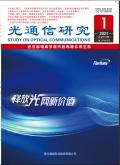The priority wavelength release protocol for dynamic wavelength allocation in WDM-TDMA PONs supporting random and quasi-random bursty traffic
引用次数: 6
Abstract
Passive Optical Networks (PONs) are attractive fiber-based access systems providing broadband access solutions at a low cost. A hybrid Wavelength Division Multiplexing (WDM) - Time Division Multiple Access (TDMA) PON is a favorite PON configuration, in which the researchers have drawn much attention. We have analysed and proposed several protocols for dynamic wavelength allocation in a WDM-TDMA PON, by separately considering random or quasi-random input-traffic. By modelling the bursty in-service traffic as an ON-OFF model, we have proposed three protocols for random call arrivals. The same protocols have also been proposed for quasi-random call arrivals, resulting however in different evaluation conclusions (than in the case of random arriving calls). This fact gave rise to a fourth protocol, the Priority Wavelength Release (Pr-WR) Protocol, suitable for quasi-random input-traffic. According to this protocol, the service-classes accommodated in the PON are distinguished in two groups: the high and low priority groups. A connection between an Optical Node Unit (ONU) and the Optical Line Terminal (OLT) (the common link of the PON) can be terminated and the occupied wavelength is released, only when the common link is empty or holds low priority calls in state OFF. In this paper, we examine the Pr-WR protocol in the WDM-TDMA PON under a mixture of quasi-random and random arriving calls. The ON-OFF teletraffic model for the mixture of random and quasi-random arrivals is presented. We evaluate the behaviour of this protocol in comparison with the other three protocols in respect of: a) the Connection Failure Probability (due to the unavailability of a wavelength), and b) the Delay (low priority calls may delay in state OFF, until a new wavelength becomes available upon a new call arrival). For the Pr-WR Protocol, we also calculate the Call Blocking Probability (due to the restricted bandwidth of the wavelength) and the Burst Blocking Probability (burst of calls delays in state OFF, due to temporal unavailability of wavelength bandwidth). We come to safe conclusion which is favourite for the Pr-Wr protocol.支持随机和准随机突发业务的WDM-TDMA PONs中用于动态波长分配的优先级波长释放协议
无源光网络(pon)是一种极具吸引力的光纤接入系统,它提供了低成本的宽带接入解决方案。波分复用(WDM) -时分多址(TDMA)混合PON是一种最受欢迎的PON配置,研究人员对此非常关注。我们分别考虑随机或准随机输入流量,分析并提出了几种WDM-TDMA PON中的动态波长分配协议。通过将突发服务流量建模为一个ON-OFF模型,我们提出了三种随机呼叫到达的协议。对于准随机呼叫到达也提出了相同的协议,但是得出了不同的评估结论(与随机呼叫到达的情况相比)。这一事实产生了第四种协议,优先波长释放(Pr-WR)协议,适用于准随机输入流量。根据该协议,PON中容纳的服务类别分为两组:高优先级组和低优先级组。ONU (Optical Node Unit)与OLT (Optical Line Terminal) (PON的公共链路)之间的连接只有在公共链路为空或处于OFF状态的低优先级呼叫时才可以终止,并释放占用的波长。本文研究了准随机和随机呼叫混合到达条件下WDM-TDMA PON中的Pr-WR协议。提出了随机到达和准随机到达混合情况下的开-关通信模型。我们通过与其他三个协议的比较来评估该协议的行为:a)连接失败概率(由于波长不可用),以及b)延迟(低优先级呼叫可能延迟在状态OFF,直到新呼叫到达时新波长可用)。对于Pr-WR协议,我们还计算了呼叫阻塞概率(由于波长带宽有限)和突发阻塞概率(由于波长带宽暂时不可用,呼叫延迟在关闭状态下的突发)。我们得出了一个安全的结论,那就是Pr-Wr协议的最佳选择。
本文章由计算机程序翻译,如有差异,请以英文原文为准。
求助全文
约1分钟内获得全文
求助全文

 求助内容:
求助内容: 应助结果提醒方式:
应助结果提醒方式:


